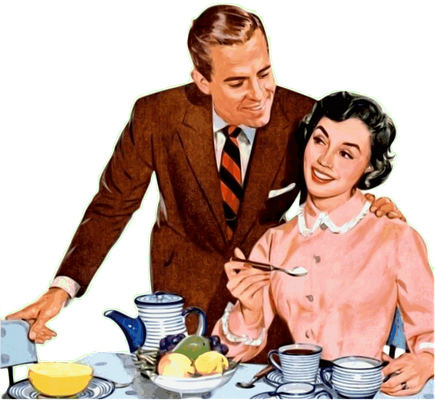4.1.1
Sex & Desire
Sex and Desire
Sex and Desire
Desire is a central strand of the play. It is this strand that provides the title. Feelings of desire, sexual desire, thwarted desire and achieved desire are the driving force of the play.


Role of Blanche DuBois
Role of Blanche DuBois
- The play is centred around Blanche DuBois, who is aware that she is subject to male desire.
- Even though she is an older woman, she is still physically attractive.
- From when we first meet her in the drama, she seems to be preoccupied with flirtation and being charming. She ignites a desire in men in ways that other women do not.


Stanley's desire for Blanche
Stanley's desire for Blanche
- Blanche's flirtatious ways ignite a sexual desire in Stanley - probably because his life with Stella has become hum-drum and uneventful.
- Blanche is the 'exotic other' and for her to take notice of him means that he must respond in some way.
- First of all, this comes out as hate, but later on, we discover that he desires her too.
- Stanley smoothes over this flirtation to Stella, but the audience is always keenly aware of the brutal desire between them.


Mitch and Blanche's desires
Mitch and Blanche's desires
- When Blanche meets Mitch, he desires to be with her.
- Blanche seems different from all the other women he has encountered.
- In the end, however, it turns out that Blanche’s need for Mitch was on a more emotional level than a sexual one.
- Mitch still has a sexual desire for her, even though he realises that he cannot marry her. His emotional desire and physical desire for her remain latent until the end of the play when he lashes out at Stanley for causing him to dump her.
Blanche's first husband
Blanche's first husband
- Blanche’s first husband was, in fact, homosexual.
- His lack of desire for her seems to have caused her to think that she has lost her desirability.
- Finding this again gives her a reason to live and is the reason why she then has sex with multiple other men.
- The Young Man who is out collecting perhaps reminds Blanche of her young husband and she hopes that he will not be homosexual in the same way that her husband was. She imposes her sexuality upon him, which scares him away.
Sex and Desire
Sex and Desire
Desire is a central strand of the play. It is this strand that provides the title. Feelings of desire, sexual desire, thwarted desire and achieved desire are the driving force of the play.


Blanche's clothing
Blanche's clothing
- Blanche manages to create sexual desires in men through her bathing and her flirtation but also through her satin and silk clothing.
- This flowing clothing calls attention to her femininity and body.


Stanley and Stella's desire
Stanley and Stella's desire
- Stella's desire for Stanley is much more traditional. Stanley’s desire for her is not as overt, but it must have been there because they are having a baby together.
- Here, Stanley is conflicted because his desire for Stella is for domesticity, stability and motherhood; very different to the kind of glamorous desire offered by Blanche.


Punishments
Punishments
- It's significant that while Blanche is punished for her desire, Stanley is not.
- Stella continues to be his wife, without question.
- Men are violent towards women and this violence ultimately goes unpunished.
- Sexual desire brings about Blanche's downfall – with her husband, the student at Laurel and with Stanley.
- Eventually, she is completely removed from society – seemingly for her desire.
1Context & Overview
1.1The Author
1.2Social Context & Setting
2Scene Summaries
2.3Scene Three
2.5Scene Five
2.6Scene Six
2.7Scene Seven
2.9Scene Nine
2.10Scene Ten
3Character Profiles
3.1Blanche DuBois & Stanley Kowalski
3.2Stella Kowalski & Harold Mitchell (Mitch)
4Key Ideas
4.1Sex & Gender
4.2Appearances, Fantasy & Reality
5Writing Techniques
5.2Genre, Form & Language
6Critical Debates
6.1Early & Modern Reception
6.2Feminist, Psychoanalytic & Marxist Approach
7Ideas About Tragedy
7.1Ideas About Tragedy
8Recap: Main Quotes
8.1Main Quotes by Scene
8.1.1Scene One - Quotations
8.1.2Scene Two - Quotations
8.1.3Scene Three - Quotations
8.1.4Scene Four - Quotations
8.1.5Scene Five - Quotations
8.1.6Scene Six - Quotations
8.1.7Scene Seven - Quotations
8.1.8Scene Eight - Quotations
8.1.9Scene Nine - Quotations
8.1.10Scene Ten - Quotations
8.1.11Scene Eleven - Quotations
Jump to other topics
1Context & Overview
1.1The Author
1.2Social Context & Setting
2Scene Summaries
2.3Scene Three
2.5Scene Five
2.6Scene Six
2.7Scene Seven
2.9Scene Nine
2.10Scene Ten
3Character Profiles
3.1Blanche DuBois & Stanley Kowalski
3.2Stella Kowalski & Harold Mitchell (Mitch)
4Key Ideas
4.1Sex & Gender
4.2Appearances, Fantasy & Reality
5Writing Techniques
5.2Genre, Form & Language
6Critical Debates
6.1Early & Modern Reception
6.2Feminist, Psychoanalytic & Marxist Approach
7Ideas About Tragedy
7.1Ideas About Tragedy
8Recap: Main Quotes
8.1Main Quotes by Scene
8.1.1Scene One - Quotations
8.1.2Scene Two - Quotations
8.1.3Scene Three - Quotations
8.1.4Scene Four - Quotations
8.1.5Scene Five - Quotations
8.1.6Scene Six - Quotations
8.1.7Scene Seven - Quotations
8.1.8Scene Eight - Quotations
8.1.9Scene Nine - Quotations
8.1.10Scene Ten - Quotations
8.1.11Scene Eleven - Quotations
Unlock your full potential with Seneca Premium
Unlimited access to 10,000+ open-ended exam questions
Mini-mock exams based on your study history
Unlock 800+ premium courses & e-books